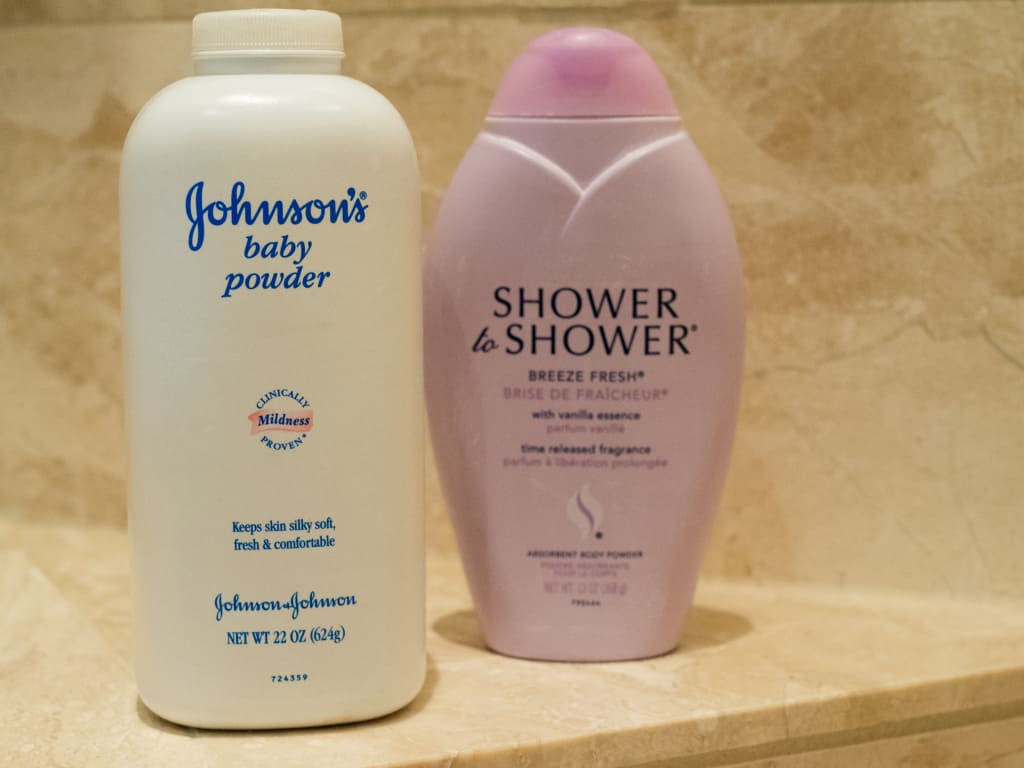Talc Found in Ovarian Tumors from Baby Powder, Shower-to-Shower or Talcum Powder Use
For decades, Johnson & Johnson has encouraged women to use popular talcum powder products on a daily basis to maintain “personal freshness”, applying Johnson’s Baby Powder or Shower-to-Shower to their body and placing it inside their underwear after every shower. However, this practice may cause talc contained in the powder to migrate into the fallopian tubes, uterus and ovaries, increasing the risk of cancer.
The lawyers at Saiontz & Kirk, P.A. now represent a number of women and families who are pursuing potential Johnson’s Baby Powder lawsuits, Shower-to-Shower lawsuits and ovarian cancer wrongful death lawsuits, with many cases involving clear evidence of talc in ovarian tumors.
Talc is a clay mineral that is used in talcum powder products as a lubricant and skin softener. While the products are primarily associated with use to help avoid diaper rash and keep a baby’s skin smooth, Johnson & Johnson has been promoting use of Baby Powder among adult women since the 1950s.
As part of a multi-generational “marketing strategy”, mothers and daughters throughout the U.S. now commonly apply Johnson’s Baby Powder or Shower-to-Shower around their genital area on a daily basis.
Although women assume it is safe to use talcum powder, there has been mounting evidence for decades that talc may travel to the ovaries and cause cancer. However, rather than disclosing this risk, the only talcum powder warnings provided on the products indicate to avoid inhaling or applying to broken areas of skin.
One of the earliest studies that highlight a potential risk of talc traveling in the female reproductive tract was published in 1961, examining the risk of carbon particles migrating, which are similar to talc.
A decade later, in 1971, researchers from the U.K. actually found evidence of talc in ovarian tumors among some women. The study indicated that talc particles were embedded deep within 10 of 13 ovarian tumors examined.
Over the past four decades, a number of similar studies have been published, with some indicating that talcum powder exposure may increase the risk of ovarian cancer by up to 92% in women who use it for feminine hygiene purposes.
As a result of Johnson & Johnson’s failure to warn about the ovarian cancer risk, and apparent decision to place their desire for profits before the safety of women nationwide, financial compensation may be available.
Investigation of Ovarian Cancer Talc Link
A diagnosis of ovarian cancer typically involves a biopsy, which is often done as part of surgery for the cancer.
Federal regulations under the Clinical Laboratory Improvement Amendments (CLIA) require labs to keep human specimens for up to 10 years in some cases, with state requirements potentially requiring tissue samples be kept longer. This means that in many situations, this crucial evidence for talc powder claims may be available long after an ovarian cancer diagnosis.
As part of the investigation of talc powder ovarian tumor lawsuits, examination of biopsy samples for regular users of Johnson’s Baby Powder, Shower-to-Shower or other products often find talc evidence, providing very strong support for cases now being pursued by women and families throughout the U.S.
Contact the talc powder lawyers at Saiontz & Kirk, P.A. provide free consultations and claim evaluations for women diagnosed with ovarian cancer and families who have lost mothers, wives and daughters to talc-related ovarian cancer.
All cases are pursued by our law firm under a contingency fee agreement, which means that there are never any out-of-pocket costs to hire our lawyers, and we only receive an attorney fee or reimbursement of expenses involved in the case if we are successful obtaining a financial recovery for you or your family.
To learn more and find out whether you or a loved one may have a case for ovarian cancer following talc powder use, request a free consultation by completing our on-line form or calling 1-800-522-0102.



1 Comment • Add Your Comments
Sandy says:
My Mom died in 1983 from ovarian cancer. She used Johnson talcum powder all her life. She died at age 61. I her daughter, was diagnosed in 1997 with ovarian cancer. She used Johnson talcum powder on me as a baby and had me use it all through my childhood. I continued to use Johnson talcum powder till I was around 19. It was then I learned talc can cause ovarian cancer. I stopped using it. I also used Johnson Talcum Powder on my patients from 1993 till the hospital stopped using it in 1996. They replaced it with cornstarch powder. Do I have a case or can I collect from my late Mom?
Posted on February 17, 2019 at 10:47 am